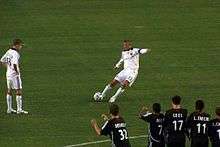Curl (football)

Curl or bend in association football is spin on the ball which will make it change direction, called a 'screw shot' in the 19th century. When kicking the ball, the inside of the foot is often used to curl the ball, but this can also be done by using the outside of the foot. Similar to curl, the ball can also swerve in the air, without the spin on the ball which makes the ball curl.
Curling or bending the ball is especially evident from free kicks, shots from outside the penalty area and crosses. Differences between balls can also affect the amount of swerve and curl: traditional leather footballs were too heavy to curl without great effort, whereas the lighter modern footballs curl with a lower effort threshold. As a general rule, the lighter and smoother the ball the more deviation there is.
Nomenclature
There is a degree of confusion surrounding the correct naming of different aspects of curl. The technique of putting curl on a ball is known as chanfle to some, from Spanish, and also as the Trivela. The deviation from the straight path in the air is the actual curl, or swerve; however, the spin on the ball that causes this is also known as the curl. Shots that curl or swerve are known as curlers, swingers, or ones that bend, also in extreme cases, banana shots. However, it is extremely rare, these days, to hear any shot described as a "banana shot".
Usage
Free kicks

Free kick takers often curl and put spin on the ball, to curl it over or around the wall of defending players, out of the reach of the goalkeeper. Goalkeepers usually organize walls to cover one side of the goal, and then stand themselves on the other side. Thus, the free kick taker has several choices, including; either to curl the ball around the wall with finesse, to bend the ball around the wall using power, or to go over the wall.
The 1950s Brazilian star Didi invented the folha seca (dry leaf) free kick, notably used by modern day players such as Cristiano Ronaldo and Juninho, where the ball would swerve downward unexpectedly at a point near the goal.[1]
Corners
Curling can be an effective technique when taking corners. The ball gradually moves in the air towards the goal. This is referred to as an in-swinging corner. Occasionally, a corner-taker will bend the ball towards the edge of the penalty area, for an attacker to volley, or take a touch and then shoot.
Passing
Curling can be used in passing. Effective passes from midfield to an attacking player are often the result of a curled pass around the defender, or long cross field passes are sometimes aided by the addition of curl or backspin.
Causes
The reason that spin on a football makes it curl is known as the Magnus effect. This causes a rotating ball to form a whirlpool about itself, with one side's air moving with the ball and the other side's air moving against the ball. This creates a difference in air pressure, and the ball deviates from its path as a result of this.[2]
The Magnus effect is named after German physicist Heinrich Gustav Magnus, who described the effect in 1852.[2] In 1672, Isaac Newton had described it and correctly inferred the cause after observing tennis players in his Cambridge college.[3][4]
Notable players
Many football players are renowned for their ability to curl or bend the ball when shooting at goal from open play or a free kick, some of which include: Pelé, Didi, Rivelino, Zico, Diego Maradona, Michel Platini, Roberto Baggio, Alessandro Del Piero, Gianfranco Zola, Siniša Mihajlović, Zinedine Zidane, Rivaldo, David Beckham, Roberto Carlos, Juninho, Ronald Koeman, Andrea Pirlo, Ricardo Quaresma, Arjen Robben, Gareth Bale, Ronaldinho, Thierry Henry, Kaka, Cristiano Ronaldo and Lionel Messi.[1][5][6][7][8][9] A 2002 film, Bend It Like Beckham, was named after Beckham's curling ability at free kicks.
See also
References
- 1 2 "Kings of the free-kick". FIFA.com. Retrieved 20 May 2014
- 1 2 G. Magnus (1852) "Über die Abweichung der Geschosse," Abhandlungen der Königlichen Akademie der Wissenschaften zu Berlin, pages 1-23.
- ↑ Isaac Newton, "A letter of Mr. Isaac Newton, of the University of Cambridge, containing his new theory about light and color," Philosophical Transactions of the Royal Society, vol. 7, pages 3075-3087 (1671-1672). (Note: In this letter, Newton tried to explain the refraction of light by arguing that rotating particles of light curve as they moved through a medium just as a rotating tennis ball curves as it moves through the air.)
- ↑ Gleick, James. 2004. Isaac Newton. London: Harper Fourth Estate.
- ↑ "The Joy of Six: classiest hat-tricks". The Guardian. Retrieved 22 August 2014
- ↑ "From Messi to Ronaldo – the world's best free kick takers". Telegraph. Retrieved 4 November 2012
- ↑ "Watch Real Madrid's Gareth Bale curl in a mesmerizing free kick from 35 yards". USA Today. Retrieves 20 December 2014
- ↑ "Free-kick master Pirlo". Football Italia. 19 March 2014. Retrieved 19 July 2015.
- ↑ Martin Mazur (1 November 2007). "Gianfranco Zola: One-on-One". Four Four Two. Retrieved 21 July 2015.
External links
- BBC Sport Academy guide on how to curl the ball
- Trivela examples and technique description from Ricardo Quaresma
- Has ball technology gone too far?
- What is the Trivela ?
- trivela